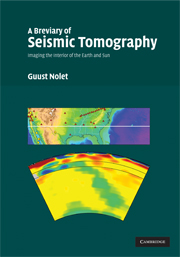Book contents
- Frontmatter
- Contents
- Preface
- 1 Introduction
- 2 Ray theory for seismic waves
- 3 Ray tracing
- 4 Wave scattering
- 5 Body wave amplitudes: theory
- 6 Travel times: observations
- 7 Travel times: interpretation
- 8 Body wave amplitudes: observation and interpretation
- 9 Normal modes
- 10 Surface wave interpretation: ray theory
- 11 Surface waves: finite-frequency theory
- 12 Model parametrization
- 13 Common corrections
- 14 Linear inversion
- 15 Resolution and error analysis
- 16 Anisotropy
- 17 Future directions
- References
- Author index
- General index
11 - Surface waves: finite-frequency theory
Published online by Cambridge University Press: 24 January 2011
- Frontmatter
- Contents
- Preface
- 1 Introduction
- 2 Ray theory for seismic waves
- 3 Ray tracing
- 4 Wave scattering
- 5 Body wave amplitudes: theory
- 6 Travel times: observations
- 7 Travel times: interpretation
- 8 Body wave amplitudes: observation and interpretation
- 9 Normal modes
- 10 Surface wave interpretation: ray theory
- 11 Surface waves: finite-frequency theory
- 12 Model parametrization
- 13 Common corrections
- 14 Linear inversion
- 15 Resolution and error analysis
- 16 Anisotropy
- 17 Future directions
- References
- Author index
- General index
Summary
Because of the stronger heterogeneity near the surface of the Earth, surface waves are even more prone to the effects of scattering than the teleseismic P- and S- waves. Only at rather low frequencies is it safe to assume that scattering can be ignored, but this is of course also the frequency band where the approximations of ray theory become questionable. Detailed studies on the validity of asymptotic approximations by Park, Kennett and Nolet and Clévédé et al. show that the approximations of ‘ray theory’ for surface waves can be problematic even for rather smooth Earth models. Lateral heterogeneity poses even stronger problems for the inversion of group velocity, which is theoretically an interference phenomenon between neighbouring frequencies, as expressed by the differentiation with respect to frequency in (10.4). When the Earth is laterally heterogeneous, waves travelling different paths may equally well interfere and significantly perturb the time of arrival of the maximum energy at a particular frequency, robbing the group arrival time of its conventional interpretation.
Phase velocity measurements also display significant oscillations due to interference of multipathed arrivals. When using ray theory (Chapter 10) there is no other solution but to average over many observations (Pedersen,). First-order scattering should at least be able to model some of the multipathed energy, and this has led to efforts to extend finite-frequency theory to surface wave observations.
Information
- Type
- Chapter
- Information
- A Breviary of Seismic TomographyImaging the Interior of the Earth and Sun, pp. 208 - 218Publisher: Cambridge University PressPrint publication year: 2008
